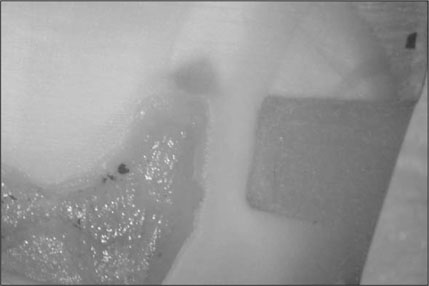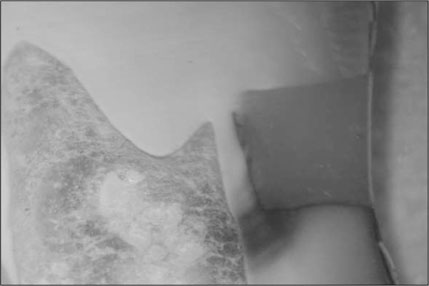J Korean Acad Conserv Dent.
2007 Sep;32(5):469-475. 10.5395/JKACD.2007.32.5.469.
Effect of a new resin monomer on the microleakage of composite resin restorations
- Affiliations
-
- 1Department of Conservative Dentistry, Seoul National University Bundang Hospital, Korea.
- 2Department of Oral Maxilofacial Surgery, Seoul National University Bundang Hospital, Korea.
- 3Department of Conservative Dentistry, School of Dentistry, Seoul National University, Korea. chobh@snu.ac.kr
- 4Dental Research Institute, Seoul National University, Korea.
- KMID: 2175940
- DOI: http://doi.org/10.5395/JKACD.2007.32.5.469
Abstract
- The purpose of this study was to evaluate the effect of a new resin monomer on the microleakage of composite resin restorations. By adding new methoxylated Bis-GMA (Bis-M-GMA, 2,2-bis[4-(2-methoxy-3-methacryloyloxy propoxy) phenyl] propane) having low viscosity, the content of TEGDMA which has adverse effects on polymerization shrinkage might be decreased. As a result, microleakage might be improved. 2 mm x 2 mm x 2 mm cavities with occlusal margins in enamel and gingival margins in dentin were prepared on buccal and lingual surfaces of 40 extracted human premolars. Prepared teeth were randomly divided into four groups and restored with Clearfil SE bond (Kuraray, Japan) and one of experimental composite resins; EX1, Experimental composite resin1 (Bis-M-GMA/TEGDMA = 95/5 wt%, 40 nm nanofillers); EX2, Experimental composite resin2 (Bis-M-GMA/TEGDMA = 95/5 wt%, 20 nm nanofillers); EX3, Experimental composite resin3 (Bis-GMA/TEGDMA = 70/30 wt%, 40 nm nanofillers); and Filtek Z250 (3M ESPE, USA) was filled as a control group. The restored teeth were thermocycled, and immersed in 2% methylene blue solution for 24 hours. The teeth were sectioned buccolingually with a low speed diamond saw and evaluated for microleakage under stereomicroscope. The data were statistically analyzed by Pearson Chi-Square test and Fisher Exact test (p = 0.05). The microleakage scores seen at the enamel margin were significantly lower than those of dentin margin (p = 0.007). There were no significant differences among the composite resins in the microleakage scores within each margin (p > 0.05). Bis-M-GMA, a new resin monomer having low viscosity, might in part replace high viscous Bis-GMA and might improve the quality of composite resin.
MeSH Terms
Figure
Cited by 1 articles
-
Surface roughness of experimental composite resins using confocal laser scanning microscope
JH Bae, MA Lee, BH Cho
J Korean Acad Conserv Dent. 2008;33(1):1-8. doi: 10.5395/JKACD.2008.33.1.001.
Reference
-
1. Bowen RL. Adhesive bonding of various materials to hard tooth tissues. II. Bonding to dentin promoted by a surface-active comonomer. J Dent Res. 1965. 44:895–902.
Article2. Wieczkowski G, Joynt RB, Davis EL, Yu XY, Cleary K. Leakage patterns associated with glass-ionomer based resin restorations. Oper Dent. 1992. 17:21–25.3. Cho BH, Dickens SH, Bae JH, Chang CG, Son HH, Um CM. Effect of interfacial bond quality on the direction of polymerization shrinkage flow in resin composite restorations. Oper Dent. 2002. 27:297–304.4. Aguiar FHB, Santos AJS, Groppo FC, Lovadino JR. Quqntititive evaluation of marginal leakage of two resin composite restorations using two filling techniques. Oper Dent. 2002. 27:475–479.5. Alani AH, Toh CG. Detection of microleakage around dental restorations: a review. Oper Dent. 1997. 22:173–185.6. Going RE. Microleakage around dental restorations: a summarizing review. J Am Dent Assoc. 1972. 84:1349–1357.
Article7. Hannig M, Fu B. Effect of air abrasion and resin composite on microleakage of class V restoration bonded with self etching primers. J Adhes Dent. 2001. 3:265–272.8. Davidson CL, Feilzer AJ. Polymerization shrinkage and polymerization shrinkage stress in polymer-based restorations. J Dent. 1997. 25:435–440.
Article9. Thompson VP, Williams EF, Bailey WJ. Dental resins with reduced shrinkage during hardening. J Dent Res. 1979. 58:1522–1532.
Article10. Stansbury JW. Synthesis and evaluation of new oxaspiro monomers for doulble ring-opening polymerization. J Dent Res. 1992. 71:1408–1412.
Article11. Moon EJ, Lee JY, Kim CK, Cho BH. Dental restorative composites containing 2,2-bis-[4-(2-hydroxy-3-methacryloyloxy propoxy) phenyl] propane derivatives and spiro orthocarbonates. J Biomed Mater Res B Appl Biomater. 2005. 73:338–346.
Article12. Kalachandra S, Sankarapandian M, Shobha HK, Taylor DF, McGrath JE. Influence of hydrogen bonding on properties of Bis-GMA analogs. J Mater Sci Mater Med. 1997. 8:283–286.13. Kim Y, Kim CK, Cho BH, Son HH, Um CM, Kim OY. A new resin matrix for dental composite having low volumetric shrinkage. J Biomed Mater Res B Appl Biomater. 2004. 70:82–90.
Article14. Kim JW, Kim LU, Kim CK, Cho BH, Kim OY. Characteristics of novel dental composites containing 2,2-bis[4-(2-methoxy-3-methacryloxy-propoxy) phenyl] propane as a base resin. Biomacromolecules. 2006. 7:154–160.
Article15. Kim LU, Kim JW, Kim CH. Effect of molecular structure of the resins on the volumetric shrinkage and the mechanical strength of dental restorative composites. Biomacromolecules. 2006. 7:2680–2687.
Article16. Prakki A, Tallury P, Mondelli RFL. Influence of additives on the properties of Bis-GMA/Bis-GMA analog comonomers and corresponding copolymers. Dent Mater. 2007. (E-pub ahead of print).
Article17. Anseth KS, Newman SM, Bowman CN. Polymeric dental composites: properties and reaction behavior of multimethacrylate dental restorations. Adv Polym Sci. 1995. 122:177–217.
Article18. Braden M. The formulation of composite filling materials. Oper Dent. 1978. 3:97–102.19. Dickens SH, Cho BH. Interpretation of bond failure through conversion and residual solvent measurements and Weibull analyses of flexural and microtensile bond strengths of bonding agents. Dent Mater. 2005. 21:354–364.
Article20. Sakaguchi RL, Peters MCRB, Nelson SR, Douglas WH, Poort HW. Effects of polymerization contraction in composite restorations. J Dent. 1992. 20:178–182.
Article21. Bausch JR, Lange KD, Davidson CL, Peters A, de Gee AJ. Clinical significance of polymerization shrinkage of composite resins. J Prosthet Dent. 1982. 48:59–67.
Article22. Goldman M. Polymerization shrinkage of resin-based restorative materials. Aust Dent J. 1983. 28:156–161.
Article23. Kim JJ, Moon HJ, Lim BS, Lee YK, Rhee SH, Yang HC. The effect of nanofiller on the opacity of experimental composites. J Biomed Mater Res B Appl Biomater. 2007. 80:332–338.
Article24. Kim IS, Min KS, Shin DH. Microleakage of various composite resin systems. J Korean Acad Conserv Dent. 2003. 28:127–133.
Article25. Kang SH, Kim OY, Oh MH, Cho BH, Um CM, Kwon HC, Son HH. Microleakage of microfill and flowable composite resins in class V cavity after load cycling. J Korean Acad Conserv Dent. 2002. 27:142–149.
Article26. Barnes DM, McDonald NJ, ThomsonVP , Blank LW, Shires PJ. Microleakage in facial and lingual class 5 composite restorations: A comparision. Oper Dent. 1994. 19:133–137.27. Gordon M, Plasschaert AJM, Saiku JM, Pelzner RB. Microleakage of posterior composite resin materials and an experimental urethane restorative material tested in vitro above and below the cementaoenamel junction. Quintessence Int. 1986. 17:11–15.28. Fayyad MA, Shortall AC. Microleakage of dentin-bonded posterior composite restoration. J Dent. 1987. 15:67–72.29. Lee IB, Lee JH, Cho BH, Son HH, Lee ST, Um CM. Rheological properties of resin composites according to the change of monomer and filler compositions. J Korean Acad Conserv Dent. 2004. 29:520–531.
Article
- Full Text Links
- Actions
-
Cited
- CITED
-
- Close
- Share
- Similar articles
-
- Effect of resin sealants on the reduction of microleakage in composite restorations
- Effect of biscover on the marginal microleakage of composite resin restoration
- Comparison of microleakage after load cycling for nanofilled composite resin fillings with or without flowable resin lining
- The Effect of Three Surface Sealants on Microleakage of Class V Composite Resin Restorations
- The effect of marginal microleakge according to thickness of flowable resin




